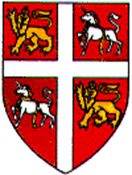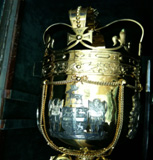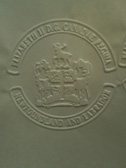- The Coat Of Arms
- The Provincial Motto of Newfoundland and Labrador
- The Escutcheon, Crest, or Shield
- The Mace of the House of Assembly of Newfoundland and Labrador
- The Great Seal Deputed of Newfoundland and Labrador
- Newfoundland and Labrador Book of Remembrance
The Coat Of Arms

History and Authority
The Coat of Arms was granted by Royal Warrant of H.M. King Charles I of England, 1 January 1637.
Following the original grant of arms, their existence was forgotten until the 1920s when inquiries by the Imperial War Graves Commission caused their rediscovery and a recertification of the original grant by the Garter King of Arms on 18 February 1925. On 1 January 1928 they were officially readopted by the Government of Newfoundland.
The Coat of Arms Act provides the current legal authority for usage.
Usage and Practical Application
Pursuant to section 5 of the Coat of Arms Act, the Coat of Arms may not be assumed, used, published, reproduced, imitated, or broadcast without written permission of the Registrar General. Permission should be pursued via the Deputy Minister of Municipal and Provincial Affairs.
Modern artistic renditions of the Coat of Arms may be commissioned only by the Executive Council of the Province of Newfoundland and Labrador.
The Provincial Motto of Newfoundland and Labrador
Quaerite Prime Regnum Dei, (Latin)
Translated: “Seek Ye First the Kingdom of God”
History and Authority
Sailing on the Matthew, the explorer Zuan Cabot sighted Newfoundland on 24 June 1497. The motto is derived from the Gospel according to St. Matthew, Ch 6, verse 33.
Confirmation of the provincial motto is granted with the Coat of Arms, 1637, and the current Coat of Arms Act.
The Escutcheon, Crest, or Shield

History and Authority
Confirmation of the Shield is granted with the Coat of Arms, 1637, and the current Coat of Arms Act.
Usage and Practical Application
Occasionally used in lieu of the complete Coat of Arms. Written Permission of the Registrar General (the Minister of Municipal and Provincial Affairs) is required to publish, reproduce, or broadcast the image of the Shield. Permission can be pursued via the Deputy Minister of Municipal and Provincial Affairs.
The Mace of the House of Assembly of Newfoundland and Labrador

History and Authority
The principal symbol of the authority of the Parliament of Newfoundland and Labrador in Legislative Assembly Convened.
Presented to the House of Assembly on 5 April 1950 as a gift to the Province of Newfoundland and Labrador of the Province of British Columbia by Deputy Premier of British Columbia, Herbert Anscomb.
In the four panels on the side of the bowl are the Coats of Arms of Canada, Newfoundland and Labrador, British Columbia, and the Monarch of Canada in 1950, King George VI. Above the bowl is a life-size replica of St. Edward’s Crown, used in the coronation of the Sovereigns of Canada, a symbol that Canada is a democratic constitutional monarchy.
Usage and Practical Application
The House of Assembly may not meet except in the presence of the Mace, which is entrusted to the Sergeant-at-Arms of the House of Assembly for safekeeping. During regular proceedings of the House of Assembly, the Mace rests on the Table of the House. During sittings of Committee of the Whole, or other Legislative Committees, the Mace is removed from the surface of the Table and placed in special arms before the Table. At the Installation of the Lieutenant Governor, and during Speeches from the Throne and other Vice-Regal visits, as well as during visits of the Sovereign to the Legislature, the Mace is borne on the shoulder of the Sergeant-at-Arms in procession before them at all times.
The Great Seal Deputed of Newfoundland and Labrador

History and Authority
Adopted by Order-in-Council in 1964 by the Smallwood administration. At the accession of each new monarch, a new Great Seal is by custom granted, or, a warrant for the continued usage of the existing seal is issued. The Great Seal Deputed of Newfoundland was first used in 1827 and its design and devices have changed with the accession of every monarch upon the approval of the Executive Council.
Usage and Practical Application
At the swearing of a new Lieutenant Governor, the Vice-Regal person is sworn as Keeper of the Seal. The Seal is then entrusted to the Registrar General for safekeeping and may be used to certify official documents and commissions. At the accession of a new monarch, by custom the approval of a new seal is sought from the Lieutenant-Governor in Council.
Newfoundland and Labrador Book of Remembrance

History and Authority
With pages made of vellum and bound in seal-skin, the Newfoundland and Labrador Book of Remembrance is enshrined in the Altar of Remembrance in the Lobby of Confederation Building, St. John’s. Copies of the Books of Remembrance are also enshrined in Altars located in the Memorial Chamber of the Peace Tower at the House of Commons Ottawa; the Memorial Chamber of the Beaumont Hamel Interpretive Centre at Beaumont Hamel, France, and in the lobby of the Arts and Administration Building, Memorial University at St. John’s.
Usage and Practical Application
From time to time the pages are turned to commemorate those named therein who made the supreme sacrifice of their lives for their country.
